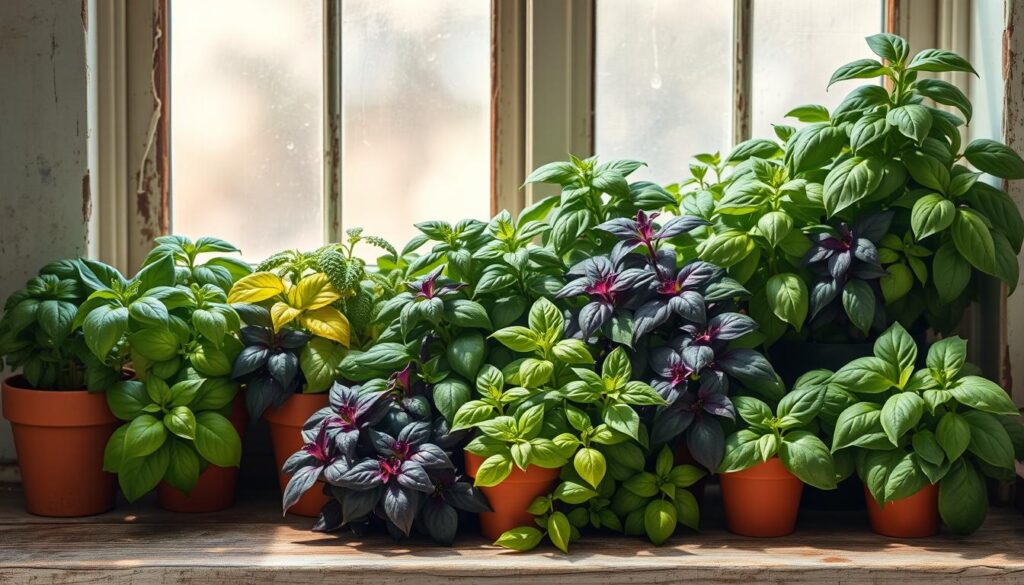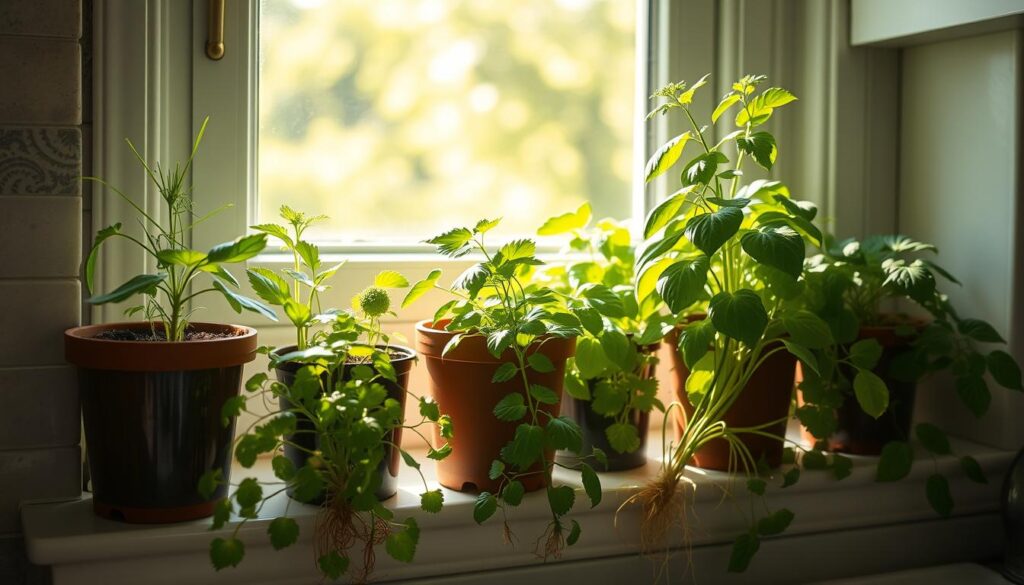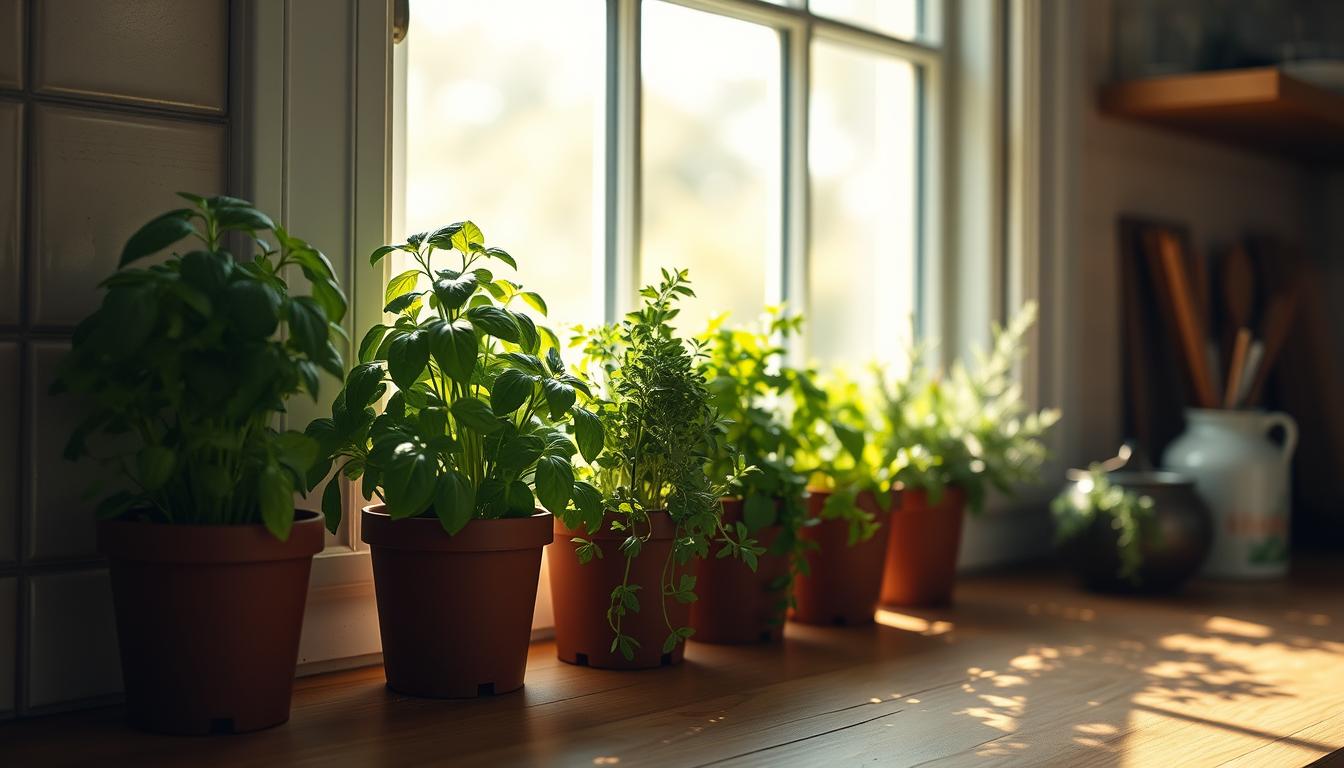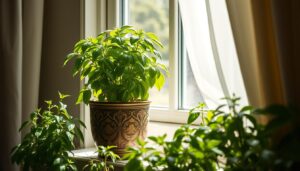Did you know 93% of Americans grow their own herbs? It’s easy and fun to have a kitchen windowsill herb garden. You can add fresh, tasty ingredients to your meals. Whether you’re experienced or new to gardening, many compact herbs will do well in your small space.
Key Takeaways
- Many herbs thrive on a kitchen windowsill, providing fresh, flavorful ingredients year-round.
- Herbs like thyme, chives, oregano, and rosemary can grow well with minimal water and attention.
- Proper pot selection and well-draining soil are key to successful container gardening on the windowsill.
- Basil, a versatile annual herb, can also be grown indoors with the right lighting and temperature conditions.
- Transitioning herbs from the garden to the windowsill or growing them from seed or cuttings can be a rewarding DIY project.
Introduction to Growing Herbs Indoors
If you love cooking and fresh herbs, don’t worry about not having outdoor space. You can grow herbs indoors on your kitchen windowsill. It’s a fun and rewarding way to have fresh herbs at home. With the right care, many herbs can grow well indoors, adding flavor to your cooking.
To grow herbs indoors, know what your plants need. Choose the right containers and make sure they get enough light and water. With a little effort, you can have a beautiful indoor herb garden. This will make your kitchen feel more like a garden.
“Herbs are the gateway to flavor, and growing them indoors allows you to enjoy that fresh-from-the-garden taste year-round.”
Anyone can enjoy the joy of having a windowsill herb garden. We’ll cover the basics of indoor herb gardening. You’ll learn how to make your kitchen feel like a garden oasis.
Choosing the Right Containers and Soil
Choosing the right containers and soil is key for growing herbs indoors. You don’t need fancy or expensive herb planters to start with container gardening. Almost any pot or container with drainage holes can work for your herb planter.
Pot Selection
Go for the biggest pot you can find to give your herbs’ roots plenty of room. This means you’ll get a bigger, healthier plant that gives you more to harvest. Small containers can limit root growth and slow down the plant’s growth.
Potting Mix Requirements
Don’t use regular garden soil for container gardening. It can get compacted in pots, hurting the roots. Instead, pick a premium, fast-draining potting mix with perlite or vermiculite. These help keep the soil airy and improve drainage, helping your indoor herbs grow well.
“The key to successful indoor herb gardening is to provide the right growing conditions, starting with the right container and soil mix.”
By choosing the right pot size and a quality, fast-draining potting mix, you’re on your way to a thriving indoor herb garden on your kitchen windowsill.
Lighting and Temperature Needs
To grow herbs indoors, you must consider the right herb growing conditions. This includes the optimal temperature for indoor herbs and indoor herb lighting needs. With the right environment, your herbs will flourish on your kitchen windowsill.
Herbs love bright spots, like big sunny windows, sunrooms, or rooms with skylights. These places offer the 6-8 hours of sunlight herbs need. If your space lacks enough natural light, you might need to use indoor herb lighting to help your herbs.
The best temperature for indoor herbs is between 55 and 75 degrees Fahrenheit. Don’t put your herbs near cold spots, like right next to a window, as the temperature changes can stress them. Good air circulation is key to prevent mold or disease.
| Herb | Ideal Temperature Range | Lighting Requirements |
|---|---|---|
| Basil | 65-85°F | 6-8 hours of direct sunlight |
| Rosemary | 60-70°F | 4-6 hours of direct sunlight |
| Thyme | 55-70°F | 6-8 hours of direct sunlight |
By giving your indoor herbs the right lighting and temperature conditions, they’ll have a great chance to thrive. You’ll enjoy a rich harvest right from your kitchen windowsill.
Watering and Fertilizing Tips
Keeping the right moisture and giving your herbs the right nutrients is key for their growth. By using simple watering and fertilizing methods, your kitchen herbs will stay healthy and bright.
Watering Techniques
The amount of water your indoor herbs need changes based on their size, the type of container, and the season. In winter, when plants are less busy, they need less water. Let the soil dry out a bit before watering again for most herbs. But, keep the soil a bit moist for basil, chives, mint, and parsley.
As spring comes, your herbs will grow more and need more water to keep the soil damp.
Fertilizer Options
- Liquid herb fertilizer: Use a liquid fertilizer every four weeks in the growing season to give your herbs the nutrients they need.
- Organic fertilizer granules: You can also use organic fertilizer granules, scratching them into the soil every other month for extra nourishment.
Choosing between a liquid herb fertilizer or organic fertilizer granules is up to you. But, the right indoor herb watering and liquid fertilizer will make your herbs flourish on your kitchen windowsill.
Best herbs for kitchen windowsill
If you dream of a lush herb garden but lack outdoor space, don’t worry! There are many top herbs for indoor growing perfect for your kitchen windowsill. These best culinary herbs for windowsill not only taste great but also bring greenery and fragrance to your home.
Think about growing compact herbs for small spaces like chives, mint, garden cress, basil, parsley, coriander, rosemary, sage, and thyme. These herbs are easy to care for and love the bright, sunny spots on a windowsill.
- Chives: Delicate, onion-flavored leaves that add a burst of flavor to soups, salads, and omelets.
- Mint: A versatile herb with a refreshing aroma, perfect for teas, mojitos, and garnishes.
- Garden Cress: A peppery, nutrient-rich microgreen that’s easy to grow and adds a flavorful crunch to dishes.
With proper care, these kitchen windowsill herbs can give you a steady supply all year. They’ll make your cooking better and fill your home with garden scents.
“Growing herbs on your windowsill is a simple way to enjoy fresh, flavorful ingredients right at your fingertips.”
Basil: A Versatile Annual
Basil (Ocimum basilicum) is a favorite herb that grows well indoors and outdoors. It comes in many varieties, each with its own taste and growth style. This makes it a great choice for your kitchen windowsill garden.
Basil Varieties
Discover the wide range of basil types to find the best one for your indoor garden. Classic Genovese basil has a strong smell and taste. Lemon basil adds a fresh citrus flavor. For small spaces, Spicy Globe basil grows to be about 8-10 inches tall. And for a Thai twist, Siam Queen basil is perfect.
Choosing any basil variety, you can grow it from seeds indoors. It germinates in 7-14 days. This makes it perfect for indoor gardeners starting out.
“Basil is the ultimate culinary herb – fragrant, versatile, and a favorite in countless dishes from pesto to pizza.”

Basil is a top choice for growing basil indoors and basil varieties for containers. It’s known for its many flavors and easy care. Add this culinary basil to your kitchen garden for a lot of fresh, fragrant leaves to make your cooking better.
Perennial Favorites: Rosemary and Thyme
When it comes to growing perennial culinary herbs indoors, rosemary and thyme are top choices. These herbs are not only easy to care for but also add amazing flavors to your cooking. They bring unique aromas and tastes to your dishes.
Rosemary has needle-like leaves and smells like pine. It comes in both trailing and upright types. For a neat look, pick the ‘Blue Boy’ rosemary. For more flavor, go for ‘Taylor’s Blue’ or ‘Salem’ upright varieties.
Thyme is great for cooking and comes in many types. Lemon thyme and French thyme are favorites for their strong flavors. If you want something different, try ‘Oregano’ thyme for its mix of thyme and oregano tastes.
| Herb | Variety | Characteristics |
|---|---|---|
| Rosemary | Blue Boy | Compact, upright growth habit |
| Rosemary | Taylor’s Blue, Salem | Upright growth habit with intense flavor |
| Thyme | Lemon Thyme, French Thyme | Robust, savory flavors |
| Thyme | Oregano Thyme | Combines thyme and oregano flavors |
Whether you’re growing rosemary indoors or trying out growing thyme indoors, these perennial culinary herbs will be key to your cooking. They’re perfect for adding flavor to your meals.
Growing Herbs from Seeds vs. Cuttings
When it comes to growing herbs for your kitchen windowsill, you have two main options: growing them from seeds or propagating them from cuttings. Each method has its own advantages and considerations to keep in mind.
Seed-Starting Process
Herbs like basil, parsley, and cilantro often perform best when grown indoors from seed. Start by filling a seed tray or small pots with a sterile, medium-weight potting mix. Gently press the seeds into the soil, then lightly cover them with milled sphagnum moss. Keep the soil moist by covering the pots with a plastic bag or glass plate until the seeds germinate.
While seed-grown herbs may not reach the same size as their outdoor counterparts, they’ll still provide you with a steady supply of fresh, flavorful leaves. Plus, you can harvest the young plants within a few weeks of germination.
Propagating from Cuttings
If you have an established outdoor herb garden, you can also bring some of your favorite perennial herbs indoors by propagating them from cuttings. Plants like sage, oregano, lemon balm, mint, and thyme can be divided and potted up about three weeks before the first frost. This allows the cuttings to take root and acclimate to their new indoor environment before the cold weather sets in.
Propagating herbs from cuttings is a great way to maintain your favorite varieties without having to start from seed each year. With a little care and attention, these hardy perennials will continue to thrive on your kitchen windowsill.
| Herb | Seed-Grown | Propagated from Cuttings |
|---|---|---|
| Basil | Best option | Not recommended |
| Parsley | Best option | Not recommended |
| Cilantro | Best option | Not recommended |
| Rosemary | Can work | Best option |
| Thyme | Can work | Best option |

Whether you choose to grow your herbs from seed or propagate them from cuttings, the key is to provide them with the right growing conditions on your kitchen windowsill. With a little experimentation, you’ll soon be enjoying a bountiful harvest of fresh, flavorful herbs all year round.
Pest Control for Indoor Herbs
When you bring your favorite herbs inside, watch out for aphids and spider mites. These pests can harm your herb plants, making them unhealthy and less tasty.
Check your indoor herbs often for aphid or spider mite signs. Look for aphids on the underside of leaves or spider mite webs. If you see pests, act fast to stop them.
- Gently spray the plants with warm water to get rid of pests.
- For big infestations, put the whole plant in water for 15 minutes to kill the pests.
- As a last choice, use a mild insecticidal soap made for indoor herb pest management.
Avoid strong chemical pesticides because they can harm your herbs. With care and these safe methods, your kitchen herbs will stay healthy and pest-free.
| Pest | Symptoms | Treatment |
|---|---|---|
| Aphids | Tiny, sap-sucking insects on the undersides of leaves | Spray with tepid water, submerge in water, use insecticidal soap |
| Spider Mites | Fine webbing on the plant, leaves may appear stippled or discolored | Spray with tepid water, submerge in water, use insecticidal soap |
With proactive care and these natural methods, your indoor herbs will stay bright, tasty, and free from pests. They’ll be ready to make your cooking better.
Conclusion
Growing herbs on your kitchen windowsill is a rewarding hobby. It lets you enjoy fresh, flavorful ingredients all year. With the right containers, soil, and care, you can have a thriving indoor herb garden.
This garden will make your cooking better. You can grow classic favorites like basil and thyme or try new ones. Harvesting your own herbs is a unique joy.
Adding these herbs to your kitchen makes it special. You’ll always have fresh herbs for your cooking. Plus, you’ll love the vibrant flavors and the feeling of growing your own food.
So, start growing herbs indoors and turn your kitchen windowsill into a garden. Enjoy the benefits of having fresh herbs at your fingertips. Make your kitchen a place of beauty and functionality with your own herb garden.
FAQ
What are some of the best herbs for growing on a kitchen windowsill?
How much light do indoor herbs need?
What type of containers and soil should I use for growing herbs indoors?
How do I water and fertilize my indoor herbs?
What are some tips for growing basil, rosemary, and thyme indoors?
How do I deal with pests on my indoor herbs?
Source Links
- Kitchen Herbs Windowsill Grow Kit – https://buzzyseeds.com/products/kitchen-herb-windowsill-garden
- Growing Herbs on Your Windowsill – https://www.chicagobotanic.org/plantinfo/growing_herbs_your_windowsill
- 13 herbs to grow in your kitchen, with tips on getting started and keeping them growing – https://www.oregonlive.com/hg/2012/01/13_herbs_worth_growing_indoors.html





